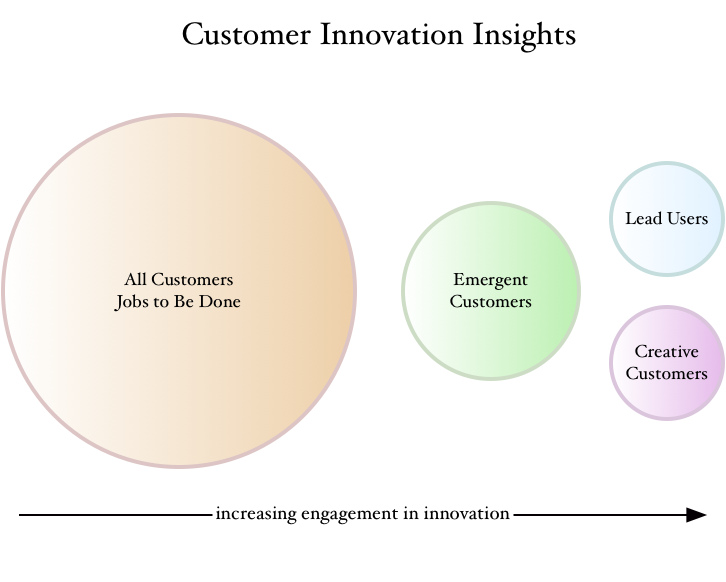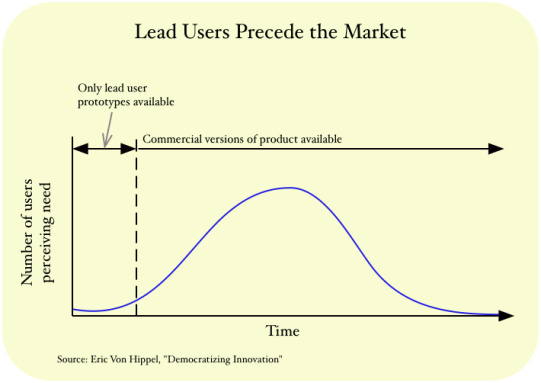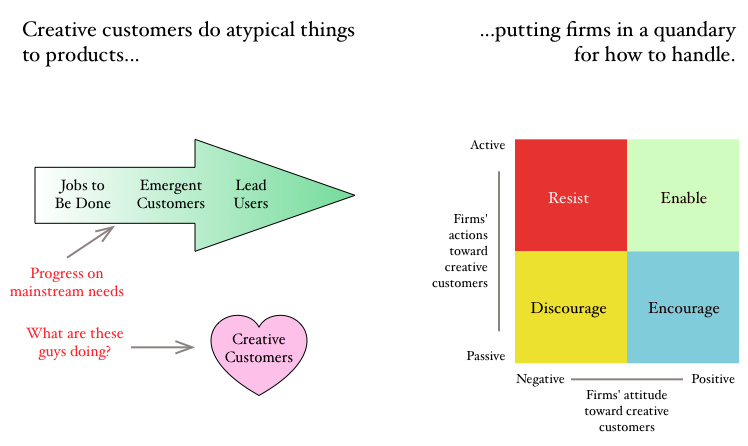4 ways to grow your business with customers
Now we are witnessing a real “concusualization” of business philosophy. Once Peter Drucker (Peter Drucker) created his famous customer-oriented theory of business , and now in the fashion of "social CRM". Last year, Altimeter published 18 examples of this approach, and among them were several, closely related to innovation. Clients are a rich source of insights for innovation, and it is they who make it possible to understand which innovations are really worthwhile. Therefore, it would be nice to understand what information, useful for a variety of improvements, customers can give you. Okay, not bad - it's vital. Despite the fact that the process of engaging clients in the creation of innovations, in general, is still in its infancy, in the future it will be buyers who will be the main source of information for thinking for any business. It just takes a little time.
So, data that can be obtained from customers usually has a certain structure. Such information may take different forms:

')
The degree of involvement in the process of creating innovations for different types of clients varies
Based on the research data, four main types of customers can be distinguished, which can provide business with different usefulness information. Consider them in more detail.
What kind of "problem solving"? This is why someone buys your product. The classical formulation of this concept, proposed by Theodore Levitt, sounds like:
This is where the concept of “problem” begins. But in fact, often buying something does not pursue such a direct profit. If you look at the diagram, it will become clear that when moving to the right (along the abscissa), the context of consumption and the emotional effect are also taken into account. The context allows you to take a broader look at the problems facing the client. Accounting for the emotional component provides an opportunity to expand the discussion to consider the very experience of using the product.
Clayton Christensen gives an excellent example of this approach. It consists in presenting to solve what “problem” people “hire” a milkshake. Yes, yes, milkshake. There is more to this purchase than just a sweet, cold drink. 40% of all cocktails are bought in the morning. Accordingly, the context of consumption is as follows - people buy a drink on their way to work instead of breakfast. The emotional effect of consuming a milkshake is relieving boredom and satisfying hunger at the beginning of the day.
Of all the possible data types for innovation, “problem solving” is the most diverse. The challenge here is that all the necessary information is hidden inside the minds of people, and it must somehow get out of there. Many companies that successfully use this approach, conduct detailed interviews with customers.
Suppose you have a product concept, and you want to test its applicability to solving problems for potential customers. In short, find out what will work, what does not, and understand what other steps should be taken before bringing the product to the market. Will your old buyers help here? It turns out - no. In this case, you need the so-called "emerging customers."
A study conducted by professors from UC-Riverside and Dartmouth Tuck School of Business showed that buyers, who are only trying to understand what product characteristics are more important for them, could provide much more useful information about the applicability and attractiveness of a particular concept.
These people have “the unique ability to imagine and imagine what changes to make to the concept in order to make the product more in demand on the market”.
Sounds like a pretty valuable skill, isn't it? But how to understand whether you are dealing with exactly the right people - what features distinguish such customers?
The researchers conducted two independent field testing of the products being developed - in the areas of home delivery and oral care. The purpose of the test was to verify the idea of the value of "developing customers." Tests have confirmed that buyers of this type can better predict whether the product they offer will be popular in the consumer market, and also fairly accurately suggest which types of customers will like it.
Leading users are people who adapt the company's product to solve their problems. Professor MIT and renowned economist Eric von Hippel described this type of users in detail in his book Democratizing Innovation. Why are these people so important? Because they manage to understand the potential new applications of the product, before it comes to anyone in the market. Find such users, and you will be able to find out what will excite customers in months or years. “Leading” users do not just see new applications and niches for products before anyone else, they also have a high motivation to do something in this direction. Their needs and product adaptations that they implement are extremely valuable.

In one of the examples cited by von Hippel, surgeons were such progressive users. They adapted and modified equipment and medical materials for their best applicability to their tasks, when they were faced with the fact that standard products that can be bought are not suitable for them. Almost half of such innovators were eventually recruited by equipment manufacturers. In another example, the famous company 3M arranged a real competition between ideas generated by leading users and obtained in other ways. The ideas of such people were “significantly more innovative than the ideas obtained by standard methods. In addition, they covered a much larger number of problems that new customers may encounter, which greatly expands the potentially accessible market share, and some ideas can even be developed into separate product lines, which will allow the company to achieve strategic success. ”
Find such users, and they will tell you about where the market will move.
Creative clients are uninvited guests on the path to large-scale innovations. While the tasks of users, developing customers and leading users help to understand how to make the product better and more successful, creative customers ... do not. The phenomenon of such people is well described by academics Peter R. Burton, Leyland F. Pitt, Ian McCarthy and Steven M. Cates in the study " When clients grow wiser, Managing approaches to working with creative clients ."
Researchers define creative customers as "customers who adapt, modify, or transform a proprietary product that does not imply this." In principle, it is similar to the description of the leading users, about which we spoke a couple of paragraphs above. But here, researchers share a reflection of common customer requests and certain narrowly focused innovations. It can be added that creative clients are those people whose innovations and proposals are quite far from what the average user needs, from the usual usage scenario. Therefore, it is not entirely clear how companies should interact with them:

Creative users are different
As such a creative client you can bring a guy who made furniture out of FedEx boxes. Obviously, the boxes are not meant for this. Another example is a machine that runs on Coca-Cola and Mentos candies. These are creative people, but their innovations have little in common with the interests of most customers. Of course, in a certain way they play into the hands of the brand, showing the unexpected advantages of its products (FedEx boxes are so durable that furniture can be made of them, and the Colos-Mentos mix is the source of fuel).
This broadens the range of perceptions of brand products, but such innovations also carry a number of challenges related to intellectual property, branding and corporate commitments. Researchers describe the pros and cons of such clients using a 2 × 2 matrix (see figure above), which reflects the attitude of companies to their actions. However, despite the sometimes polar attitude of brands towards such customers, they just will not disappear, and usually their number only increases. Although it is the uninvited guests at dinner, they still diversify it a little, so it’s worth paying attention to such people.
The four ways of business development described in this text with the help of clients provide entrepreneurs with a solid foundation for building entirely new relationships with customers. Despite the fact that more active involvement of clients in business processes is still a kind of novelty, this approach certainly deserves attention, because it allows not only to keep up with the times, but often ahead of the wishes of the majority of customers.
So, data that can be obtained from customers usually has a certain structure. Such information may take different forms:

')
The degree of involvement in the process of creating innovations for different types of clients varies
Based on the research data, four main types of customers can be distinguished, which can provide business with different usefulness information. Consider them in more detail.
All Customers - Problem Solving
What kind of "problem solving"? This is why someone buys your product. The classical formulation of this concept, proposed by Theodore Levitt, sounds like:
People do not want to buy a drill for concrete. They need a hole in the concrete wall.
This is where the concept of “problem” begins. But in fact, often buying something does not pursue such a direct profit. If you look at the diagram, it will become clear that when moving to the right (along the abscissa), the context of consumption and the emotional effect are also taken into account. The context allows you to take a broader look at the problems facing the client. Accounting for the emotional component provides an opportunity to expand the discussion to consider the very experience of using the product.
Clayton Christensen gives an excellent example of this approach. It consists in presenting to solve what “problem” people “hire” a milkshake. Yes, yes, milkshake. There is more to this purchase than just a sweet, cold drink. 40% of all cocktails are bought in the morning. Accordingly, the context of consumption is as follows - people buy a drink on their way to work instead of breakfast. The emotional effect of consuming a milkshake is relieving boredom and satisfying hunger at the beginning of the day.
Of all the possible data types for innovation, “problem solving” is the most diverse. The challenge here is that all the necessary information is hidden inside the minds of people, and it must somehow get out of there. Many companies that successfully use this approach, conduct detailed interviews with customers.
Developing customers
Suppose you have a product concept, and you want to test its applicability to solving problems for potential customers. In short, find out what will work, what does not, and understand what other steps should be taken before bringing the product to the market. Will your old buyers help here? It turns out - no. In this case, you need the so-called "emerging customers."
A study conducted by professors from UC-Riverside and Dartmouth Tuck School of Business showed that buyers, who are only trying to understand what product characteristics are more important for them, could provide much more useful information about the applicability and attractiveness of a particular concept.
These people have “the unique ability to imagine and imagine what changes to make to the concept in order to make the product more in demand on the market”.
Sounds like a pretty valuable skill, isn't it? But how to understand whether you are dealing with exactly the right people - what features distinguish such customers?
- Openness to new experiences and ideas.
- Tendency to reflection.
- Love to experiment.
- The ability to perceive information both verbally and visually.
- High level of creativity.
- Optimism.
The researchers conducted two independent field testing of the products being developed - in the areas of home delivery and oral care. The purpose of the test was to verify the idea of the value of "developing customers." Tests have confirmed that buyers of this type can better predict whether the product they offer will be popular in the consumer market, and also fairly accurately suggest which types of customers will like it.
Leading users
Leading users are people who adapt the company's product to solve their problems. Professor MIT and renowned economist Eric von Hippel described this type of users in detail in his book Democratizing Innovation. Why are these people so important? Because they manage to understand the potential new applications of the product, before it comes to anyone in the market. Find such users, and you will be able to find out what will excite customers in months or years. “Leading” users do not just see new applications and niches for products before anyone else, they also have a high motivation to do something in this direction. Their needs and product adaptations that they implement are extremely valuable.

In one of the examples cited by von Hippel, surgeons were such progressive users. They adapted and modified equipment and medical materials for their best applicability to their tasks, when they were faced with the fact that standard products that can be bought are not suitable for them. Almost half of such innovators were eventually recruited by equipment manufacturers. In another example, the famous company 3M arranged a real competition between ideas generated by leading users and obtained in other ways. The ideas of such people were “significantly more innovative than the ideas obtained by standard methods. In addition, they covered a much larger number of problems that new customers may encounter, which greatly expands the potentially accessible market share, and some ideas can even be developed into separate product lines, which will allow the company to achieve strategic success. ”
Find such users, and they will tell you about where the market will move.
Creative customers
Creative clients are uninvited guests on the path to large-scale innovations. While the tasks of users, developing customers and leading users help to understand how to make the product better and more successful, creative customers ... do not. The phenomenon of such people is well described by academics Peter R. Burton, Leyland F. Pitt, Ian McCarthy and Steven M. Cates in the study " When clients grow wiser, Managing approaches to working with creative clients ."
Researchers define creative customers as "customers who adapt, modify, or transform a proprietary product that does not imply this." In principle, it is similar to the description of the leading users, about which we spoke a couple of paragraphs above. But here, researchers share a reflection of common customer requests and certain narrowly focused innovations. It can be added that creative clients are those people whose innovations and proposals are quite far from what the average user needs, from the usual usage scenario. Therefore, it is not entirely clear how companies should interact with them:

Creative users are different
As such a creative client you can bring a guy who made furniture out of FedEx boxes. Obviously, the boxes are not meant for this. Another example is a machine that runs on Coca-Cola and Mentos candies. These are creative people, but their innovations have little in common with the interests of most customers. Of course, in a certain way they play into the hands of the brand, showing the unexpected advantages of its products (FedEx boxes are so durable that furniture can be made of them, and the Colos-Mentos mix is the source of fuel).
This broadens the range of perceptions of brand products, but such innovations also carry a number of challenges related to intellectual property, branding and corporate commitments. Researchers describe the pros and cons of such clients using a 2 × 2 matrix (see figure above), which reflects the attitude of companies to their actions. However, despite the sometimes polar attitude of brands towards such customers, they just will not disappear, and usually their number only increases. Although it is the uninvited guests at dinner, they still diversify it a little, so it’s worth paying attention to such people.
The four ways of business development described in this text with the help of clients provide entrepreneurs with a solid foundation for building entirely new relationships with customers. Despite the fact that more active involvement of clients in business processes is still a kind of novelty, this approach certainly deserves attention, because it allows not only to keep up with the times, but often ahead of the wishes of the majority of customers.
Source: https://habr.com/ru/post/218849/
All Articles